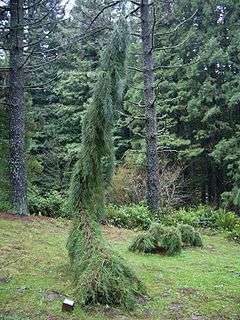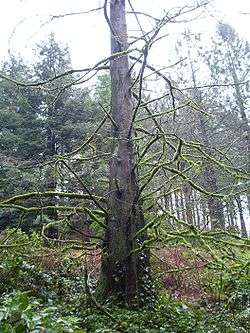Hoyt Arboretum
The Hoyt Arboretum is located atop a ridge in the west hills of Portland, Oregon, United States. The arboretum is located two miles (3 km) west of downtown Portland within Washington Park, and close to the Oregon Zoo, and the International Rose Test Garden. The Arboretum is open to the public and accessible at several points from Washington Park or from the Wildwood Trail from Forest Park.
| Hoyt Arboretum | |
|---|---|
 Weeping Sequoia (Sequoiadendron giganteum 'Pendulum') in Hoyt Arboretum | |
 Hoyt Arboretum  Hoyt Arboretum  Hoyt Arboretum | |
| Type | Arboretum |
| Location | Portland, Oregon, United States |
| Coordinates | 45.51679°N 122.71600°W |
| Area | 189-acre (76 ha) |
| Opened | 1922 |
| Visitors | 350,000 |
| Status | Open to the public |
| Website | hoytarboretum.org |
History
Hoyt Arboretum is sited on steep slopes, straddling the SW Fairview Boulevard ridge above the Oregon Zoo and the Portland Japanese Garden. The elevation of the arboretum ranges from 650 feet to 900 feet, and there are several ravines within the arboretum.[1] The hilly terrain of the arboretum was once in private hands. The United States government had granted land to American pioneers through the Donation Land Claim Act of 1850 for farming and logging, but the homesteads failed; by 1865, the land was owned by Multnomah County.[2] In 1889, the area was ravaged by a forest fire, and part of the burned land was used to build the 160 acre (64.75 hectare) Multnomah County Poor Farm Hillside Farm west of Washington Park.[2]
After the Poor Farm closed, in 1922 Multnomah County sold the land to the City of Portland, which created Hoyt Arboretum in 1930.[3] The city commissioned John W. Duncan, superintendent of parks for Spokane, Washington, to design a plan for the new arboretum. He completed the plan in 1930, and included locations for nearly forty families of trees planted in a naturalistic landscape. Works Progress Administration crews cleared the forest and built the roads and paths winding through the arboretum in 1930 and 1931, although some native trees that had grown in the wake of the 1889 fire were left in place. The arboretum was planted according to Duncan's plan from 1931 to 1944. Many trees needed to be replaced after the Columbus Day Storm of 1962.[2]
The property has since increased in size through additional donations and acquisitions to 189-acre (0.76 km2)(76 ha).
The arboretum gets about 350,000 visitors per year.[4]
Gardens/Collections

The arboretum hosts approximately 6000 individual trees and shrubs of more than 2300 species from all over the world, 63 of which are vulnerable or endangered.[5] Most have labels identifying common and scientific names and region of origin.
The arboretum contains a nationally recognized magnolia collection.[4]
The arboretum has one of the most extensive conifer collections in the United States.[2] The conifer collection includes a dawn redwood, one of only a few known deciduous conifers (needle and cone bearing trees that lose their leaves in the winter). The species was once thought extinct and known only in fossils, but was rediscovered in a remote valley in Hubei province, China in 1944. The species was reintroduced to the western hemisphere in 1948, with the Hoyt Arboretum as one of the first recipients. In the fall of 1952, the Hoyt Arboretum's dawn redwood became the first in the Western hemisphere to produce cones in about 6 million years.[6]
The Arboretum's Winter Garden showcases ornamental and native plants that display winter color.[7]
In 2016, the arboretum opened a bamboo garden billed as "the largest bamboo collection in the Pacific Northwest" and featuring over 30 species of bamboo represented by over 100 plants.[8]
Features
The arboretum has twelve miles (19 km) of trails[5] (two miles (3 km) of which are wheelchair accessible),[9] marked with over 250 trail signs and interpretive panels.[10] The Wildwood Trail which leads north to Forest Park and the Marquam Trail which leads south to Marquam Nature Park meet in the arboretum; both trails are segments of the Portland area's 40-Mile Loop trail network.
The visitor's center is located at the center of the park and contains a small nature center and research library where visitors can find information about the park and its trees; the visitor's center is also the starting point for periodic volunteer-guided tours.[9] The research library has over 800 books ranging from technical floras to beginner gardening books, and is accessible to the public.[11]
The Stevens Pavilion is a covered A-frame picnic shelter with wooden beams and stone floors, nestled in a grove of Douglas-fir trees.[12]
Public Art
- House for Summer is a living sculpture of Himalayan birch trees planted by artist Helen Lessick in 1987. The sculpture reflects the shelter of the forest canopy and changes with the seasons.[13] Park arborists maintain the work under a joint agreement with Portland's Regional Arts and Culture Council.[14]
- Basket of Air is a stainless and galvanized steel spherical sculpture by Portland artist Ivan McLean, inspired by bamboo baskets.[15] It is suspended over the pond in the arboretum's bamboo garden and was installed in 2016.
Public access
Parking at the Hoyt Arboretum costs $2 per hour, to a maximum of $8 per day.[16] The arboretum is served by TriMet bus route 63-Washington Park.[17] The Washington Park Shuttle, a free service that connects the arboretum to MAX light rail at the Washington Park station, operates daily from April through October, and only on weekends from November through March.[18]
See also
- List of botanical gardens in the United States
References
- Houck, Michael C.; Cody, M.J., eds. (2011). Wild in the City: Exploring the Intertwine. Corvallis, Oregon: Oregon State University Press. p. 118. ISBN 978-0-87071-612-6.
- Olson, Donald (2014). The Pacific Northwest Garden Tour. Timber Press, Inc. pp. 42–45. ISBN 978-1-60469-451-2.
- "History of the Hoyt Arboretum". Portland Parks and Recreation. Retrieved May 25, 2019.
- Hewitt, Lyndsey (9 April 2017). "Shake off winter with a walk in the woods at Hoyt Arboretum". Portland Tribune. Retrieved 2018-01-10.
- "About Our Collection". Hoyt Arboretum. Retrieved 2019-05-25.
- "Dawn Redwood (Metasequoia glyptostroboides)". Oregon Interactive Corporation. Retrieved 2018-01-09.
- Eastman, Janet (February 2, 2016). "A close-up look at Hoyt Arboretum: Plus winter garden care tips". The Oregonian. Advance Publications. Retrieved January 8, 2018.
- "Hoyt Arboretum Bamboo Forest". Hoyt Arboretum. Retrieved 2018-01-07.
- "General Information". Hoyt Arboretum. Retrieved 2018-01-07.
- Koffman, Rebecca (September 17, 2012). "Hoyt Arboretum unveils 250 trail and interpretive signs". The Oregonian. Advance Publications. Retrieved January 7, 2018.
- "About Our Collection". Hoyt Arboretum. Retrieved 2018-01-07.
- "Stevens Pavilion Picnic Shelter". Hoyt Arboretum. Retrieved 2018-01-08.
- "House for Summer". Regional Arts & Culture Council. Retrieved January 9, 2017.
- "House for Summer 30th Anniversary". Helen Lessick. Retrieved January 9, 2017.
- "Basket of Air". Regional Arts & Culture Council. Retrieved January 7, 2017.
- "Explore Washington Park". Washington Park Transportation Management Association. Retrieved January 7, 2018.
- "Bus Line 63-Washington Park". TriMet. Retrieved January 7, 2018.
- "Explore Washington Park Seasonal Shuttle – Daily May–October". Washington Park Transportation Management Association. Retrieved December 3, 2019.
External links
- Official Website
- The Tuesday Crew Documentary produced by Oregon Field Guide